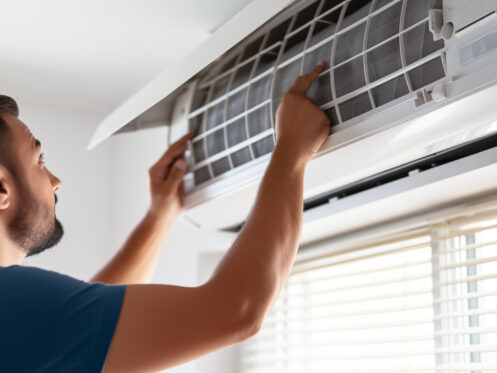If you want an efficient heating and cooling solution for your Denver, CO, home, there’s an option you may overlook. Ductless mini-splits are a type of HVAC system favored throughout much of the world. However, they have only recently started to become common in the U.S. If you’re unfamiliar with them, here’s why ductless mini-splits may be a perfect option for you.
What Is a Ductless Mini-Split?
A ductless mini-split is an HVAC system that offers efficient heating and cooling in a single, sleek package. It relies on a standalone outdoor unit that serves one or more indoor air handlers. These systems come in various capacities. Some can support as many as eight air handlers simultaneously. This means you can purchase a mini-split to serve a single room, or you can buy one that can heat and cool your entire home.
Unlike traditional HVAC solutions, mini-splits require no ductwork installation. This makes them an excellent option for older homes or those with aging ductwork. They’re also a great choice if you’re adding newly finished space to your home. Therefore, a mini-split could be ideal if you’re finishing your home’s basement or building an addition.
How Mini-Splits Work
Ductless mini-splits use heat pump technology to provide both heating and cooling. However, they operate differently than the central HVAC systems you are likely accustomed to. One notable difference is that each air handler has its own temperature controls. This means you can manage the temperature in individual rooms or spaces, and you can also leave air handlers off in areas that are not in use.
Mini-Split Cooling Mode Operation
In cooling mode, a mini-split works just like a conventional air conditioner. When you lower the temperature using an air handler’s controller, it signals the outdoor unit to start working. This turns on the large fan and compressor in the outdoor unit. The cooling cycle begins when the system passes its refrigerant through an expansion valve, which reduces its pressure and temperature. From there, the outdoor unit sends the cold refrigerant to the activated air handler.
When the cold refrigerant reaches the air handler, it opens its front louvers and turns on its fan. The fan pulls hot air from the surrounding area and pushes it over a heat exchanger. As this occurs, the cold refrigerant passes through the inside of the heat exchanger, absorbing heat energy from the room’s air and cooling it. Once the refrigerant absorbs enough heat, it boils into a vapor and travels back to the outdoor unit.
The warm refrigerant vapor then passes through the mini-split’s compressor, where its pressure and temperature increase. It subsequently passes through another heat exchanger while the large fan blows outdoor air across its fins, enabling the refrigerant to release its collected heat into the outdoor air. Afterward, it is ready to begin its journey to the expansion valve to start the process again.
Mini-Split Heating Mode Operation
Heat pumps, unlike air conditioners, can also operate in heating mode. To do this, they engage a device called a reversing valve, which changes the direction of the system’s refrigerant flow. In a mini-split, this process starts when you switch an air handler to heating mode and raise the temperature.
The mini-split then sends its low-pressure, low-temperature refrigerant to the outdoor unit rather than to your air handlers. There, it absorbs heat energy from the outdoor air because the refrigerant starts its journey at temperatures as low as -15 degrees Fahrenheit. As long as the refrigerant is colder than the outdoor air, it will absorb heat.
Once the refrigerant warms up, it passes through the compressor, raising its pressure and temperature. The hot refrigerant then moves to the activated air handler, where the process reverses. Here, it releases heat into the room’s air while passing through the unit’s heat exchanger. Once the refrigerant loses most of its heat, it travels back outside through the expansion valve, cooling it enough to begin the heating cycle again.
The Advantages of Ductless Mini-Splits
You might consider a mini-split as the HVAC solution for your Denver home for several reasons. The most important reasons include the following:
High Energy Efficiency
One of the most significant advantages of ductless mini-splits is their high energy efficiency. As heat pumps, most mini-splits can operate at a coefficient of performance of three or higher, which equates to an energy efficiency of 300%. This means they are three times as efficient in heating mode as any other conventional heating solution.
Additionally, functioning without ductwork provides mini-splits with another significant efficiency advantage. The Department of Energy estimates that ducted systems suffer an efficiency penalty as high as 30% due to leaky ductwork. These leaks result in conditioned air losses into uninsulated spaces, walls, and ceilings.
Multiple Installation Options
Mini-splits also provide installation flexibility that other HVAC solutions cannot match. The most common mini-split configuration relies on high wall-mounted air handlers. Installing them typically requires no more than a three-inch hole through the installation wall, allowing the passage of refrigerant lines and power cables that connect the air handler to the outdoor unit.
Other air handler options exist. You can choose low-wall air handlers that resemble sleek radiators or opt for low-profile ceiling cassettes. Installing those near the center of a room can ensure even heating and cooling year-round. Additionally, some mini-splits can connect to existing ductwork in your home if you prefer not to have visible air handlers.
Available Incentives
Mini-splits also qualify for various incentives and tax credits that can reduce their cost. If you are purchasing a high-efficiency mini-split, it may qualify for a federal tax credit worth up to $2,000. A state program may also provide an additional discount of $499.95 or more on a new mini-split heat pump.
Additionally, the Home Electrification and Appliance Rebates (HEAR) program can provide a discount of up to $8,000 on a new mini-split. This federally funded, income-based program offers point-of-sale rebates on efficient mini-splits. Households earning up to 150% of their area’s median income qualify.
Amazing Versatility
Finally, mini-splits offer a kind of versatility that other HVAC systems don’t possess. For example, you can install a mini-split to add supplementary heating and cooling alongside an existing central HVAC system. This option is often useful in spaces with unique requirements, such as kitchens and sunrooms, which may become hotter than other areas in your home.
You can also install a mini-split to augment your existing HVAC coverage after a remodeling project. This can be helpful if you’re relocating or removing walls, which can alter your home’s ductwork layout. Rather than redesigning your ductwork and replacing your entire HVAC system, a mini-split can provide a more cost-effective solution.
Denver Ductless Mini-Split Experts
Since 1998, Horizon Services has provided Denver homeowners with quality heating and cooling systems. Our HVAC technicians are NATE-certified, placing them in a select company among the nation’s best. As a Trane Comfort Specialist, you can expect only the most reliable HVAC systems from us. If you’re interested in a new mini-split HVAC system for your Denver home, call Horizon Services today.


